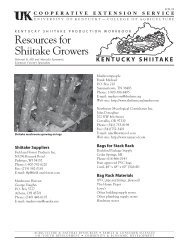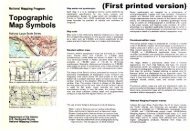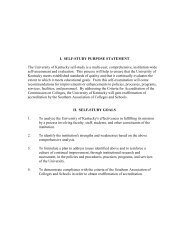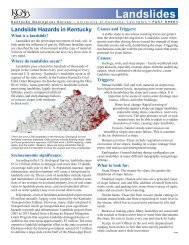Inflorescence types..
Inflorescence types..
Inflorescence types..
Create successful ePaper yourself
Turn your PDF publications into a flip-book with our unique Google optimized e-Paper software.
Back to main<br />
flower menu<br />
Flowers<br />
An inflorescence is the arrangement of flowers on the flowering stem.<br />
Next<br />
To the<br />
inflorescence menu<br />
Main menu
Pedicles<br />
Peduncle<br />
Bracts<br />
Flowers<br />
Typical parts of an inflorescence include the peduncle, pedicels,<br />
bracts and bractlets.<br />
Back to main<br />
flower menu<br />
Back<br />
Next<br />
Peduncle is the stalk holding a<br />
solitary flower or supporting the<br />
inflorescence.<br />
Pedicels are the stalks supporting<br />
each flower in the inflorescence.<br />
Bracts are modified leaf-like<br />
structures that subtend (just<br />
below) an inflorescence.<br />
To the<br />
inflorescence menu<br />
Main menu
Pedicles<br />
Peduncle<br />
Bractlets<br />
Flowers<br />
Typical parts of an inflorescence include the peduncle, pedicels,<br />
bracts and bractlets.<br />
Back to main<br />
flower menu<br />
Back<br />
Next<br />
Bractlets or bracteoles are<br />
secondary bracts usually found in<br />
the interior of the inflorescence.<br />
To the<br />
inflorescence menu<br />
Main menu
2<br />
4<br />
1 2 3 4 3 2<br />
4<br />
3<br />
3<br />
4<br />
4<br />
4<br />
1<br />
4<br />
4<br />
3<br />
1<br />
3<br />
Numbers indicate the order of flowering.<br />
2<br />
4<br />
1<br />
2<br />
3<br />
4 4<br />
3<br />
2 2<br />
4<br />
4<br />
3<br />
3<br />
Flowers<br />
There is a pattern to flower opening that is characteristic of some <strong>types</strong><br />
of inflorescences.<br />
Back to main<br />
flower menu<br />
Back<br />
1<br />
4<br />
3<br />
4<br />
3<br />
1<br />
2<br />
Centripetal flowering occurs in<br />
indeterminate inflorescences<br />
where the outer flowers open<br />
first and the innermost<br />
flowers last.<br />
Centrifugal flowering occurs in<br />
determinate inflorescences<br />
where the innermost flower<br />
opens first followed by the<br />
next outer flower. The<br />
outermost flower opens last.<br />
To the<br />
inflorescence menu<br />
Main menu
Solitary<br />
Umbel<br />
Back to main<br />
flower menu<br />
Racemic<br />
Spike<br />
Corymb<br />
Cymic<br />
Cyme<br />
Flowers<br />
<strong>Inflorescence</strong> <strong>types</strong><br />
Back<br />
Raceme<br />
Panicle<br />
Capitulum<br />
Special forms<br />
Click on a term for information<br />
Spadix Catkin<br />
Thyrse Verticillaster Spikelet<br />
Cyathium<br />
Main menu
Peduncle<br />
Solitary<br />
Flowers are solitary when a single flower is terminal on the peduncle.<br />
Back to main<br />
flower menu<br />
Bracts<br />
Flowers<br />
Sweet white trillium<br />
Trillium simile<br />
Kentucky ladyslipper<br />
Cypripedium kentuckiense<br />
Back to<br />
inflorescence menu<br />
Main menu
Spike<br />
A spike is an elongated inflorescence similar to a raceme except the flowers<br />
lack pedicels. Flowers that adhere directly to the rachis without a pedicel are<br />
termed sessile flowers. Flowers open from the base to the top in an ascending<br />
pattern.<br />
Rachis<br />
Peduncle<br />
Back to main<br />
flower menu<br />
Bractlets<br />
Next<br />
Flowers<br />
Bracts<br />
Peduncle<br />
Prairie clover<br />
Petalostemum<br />
Sessile<br />
flowers<br />
Rachis<br />
<strong>Inflorescence</strong> split to expose sessile flowers on the rachis.<br />
Back to<br />
inflorescence menu<br />
Main menu
Spike<br />
Japanese spurge produces a terminal spike of flowers without petals. The<br />
showy white flowers are stamens. Because its spike is more often you can see<br />
how each individual flower is sessile at its attachment to the rachis.<br />
Rachis<br />
Peduncle<br />
Back to main<br />
flower menu<br />
Back<br />
Next<br />
Flowers<br />
Bractlets<br />
Japanese spurge<br />
Pacysandra terminalis<br />
Back to<br />
inflorescence menu<br />
Main menu
Spike<br />
Plaintains produce elongated spikes with many flowers tightly packed together.<br />
Each small flower has papery petals and sepals with protruding white stamens<br />
that open sequentially from the base of the spike to the top.<br />
Plantain<br />
Plantago lanceolata<br />
Stamens<br />
Back to main<br />
flower menu<br />
Petals<br />
Back<br />
Next<br />
Flowers<br />
Plantain<br />
Plantago major<br />
Back to<br />
inflorescence menu<br />
Main menu
Spike<br />
Ground cone and squaw root are parasitic plants that do not produce leaves.<br />
They attach to the roots of nearby plants for survival. Once per year the<br />
spikes emerge from the ground to allow the flowers to be pollinated and seed<br />
to be produced.<br />
Ground cone broomrape<br />
Boschniakia rossica<br />
Back to main<br />
flower menu<br />
Back<br />
Flowers<br />
Back to<br />
inflorescence menu<br />
Squaw root<br />
Conopholis americana<br />
Flower<br />
Bractlets<br />
Main menu
Capitulum (Head)<br />
A capitulum or head is a round to flat topped cluster of flowers<br />
(inflorescence) containing many individual stalkless (sessile) flowers arranged<br />
around a receptacle. It is similar to a spike that has been reduced in length.<br />
Bracts when present often form an involucre surrounding the receptacle.<br />
Receptacle<br />
Peduncle<br />
Back to main<br />
flower menu<br />
Bracts<br />
Involucre<br />
Next<br />
Flowers<br />
Sea holly Eryngium tripartitum<br />
Back to<br />
inflorescence menu<br />
Torch ginger<br />
Etlingera elatior<br />
Main menu
Capitulum (Head)<br />
A capitulum or head in members of the composite family (Asteraceae) are<br />
round or roundish and contain many stalkless (sessile) flowers arranged around<br />
a receptacle. The heads can be made up of combinations of ray and disk<br />
florets. Ray flowers have a strap-like petal while disk flowers are tubular.<br />
Peduncle<br />
Back to main<br />
flower menu<br />
Back Next<br />
Flowers<br />
Receptacle<br />
Bracts<br />
Disk floret<br />
Click on highlighted term for<br />
definition or information.<br />
Ray floret<br />
Main menu
Capitulum (Head)<br />
Ray florets are usually larger and showier than disk florets but each can have<br />
both male and female parts. In a mixed head of ray and disk florets, the outer<br />
ray florets are usually sterile or female only. Each floret has fused petals and<br />
a pappus. Pappas are modified sepals of awns, scales or bristles.<br />
Ray floret Disk floret<br />
Pappus<br />
Back to main<br />
flower menu<br />
Petal<br />
Ovary<br />
Style<br />
Back<br />
Next<br />
Flowers<br />
Ray florets Disk florets<br />
Zinnia<br />
Back to<br />
inflorescence menu<br />
Main menu
Capitulum (Head)<br />
In Stokes’ aster , it is clear in the ray floret that what appears to be a single<br />
petal is actually five petals fused together. This type of ray floret with five<br />
defined “teeth” is termed ligulate. The pappas occur as bristles.<br />
Back to main<br />
flower menu<br />
Ray florets Disk florets<br />
Back<br />
Stokes’ aster Stokesia laevis<br />
Next<br />
Flowers<br />
Receptacle<br />
Back to<br />
inflorescence menu<br />
Ray floret<br />
ovary<br />
Disk<br />
floret<br />
Pappus<br />
Main menu
Capitulum (Head)<br />
Stokes’ aster also clearly shows another characteristic of the composite<br />
family. This is the grouping of numerous bracts that subtend and surround the<br />
flower head as an involucre.<br />
Ray floret<br />
Peduncle<br />
Back to main<br />
flower menu<br />
Disk florets<br />
Receptacle<br />
Back<br />
Next<br />
Flowers<br />
Bracts<br />
Involucre<br />
Stokes’ aster Stokesia laevis<br />
Back to<br />
inflorescence menu<br />
Main menu
Capitulum (Head)<br />
The cone in purple coneflower is an<br />
outgrowth of the bracts as spines. See the<br />
disk flowers between the pigmented spines.<br />
These differ from a pappas because they<br />
arise from the receptacle rather than at the<br />
base of the petals on each floret.<br />
Back to main<br />
flower menu<br />
Bract (spine)<br />
Back<br />
Next<br />
Flowers<br />
Disk floret<br />
Purple coneflower Echinacea purpurea<br />
Receptacle<br />
Back to<br />
inflorescence menu<br />
Main menu
Back to main<br />
flower menu<br />
Back<br />
Next<br />
Flowers<br />
Capitulum (Head)<br />
In some plants the pappus elongates and<br />
acts like a parachute for wind dispersal of<br />
the achene. This arrangement of specialized<br />
sepals (pappas) and achene is called a<br />
cypsella.<br />
Cypsella<br />
Goat’s beard (Tragopogon)<br />
Back to<br />
inflorescence menu<br />
Pappus<br />
Achene<br />
Ovary<br />
Main menu
Capitulum (Head)<br />
Flowering heads show centripetal flowering where the outer flowers open first<br />
and the innermost flowers last. In the examples below, the innermost flowers<br />
have yet to open.<br />
Gerbera daisy (Gerbera)<br />
Back to main<br />
flower menu<br />
Back<br />
Next<br />
Flowers<br />
Lavender cotton (Santolina)<br />
Back to<br />
inflorescence menu<br />
Main menu
Capitulum (Head)<br />
Not all composite flowers have both ray and disk flowers. Some are comprised<br />
of all ray or all disk flowers.<br />
Ox eye daisy (Heliopsis) Lavender cotton (Santolina) Dandelion (Taraxacum)<br />
Ray and disk florets<br />
Radiate head<br />
Back to main<br />
flower menu<br />
Back<br />
Next<br />
Flowers<br />
Disk florets only<br />
Discoid head<br />
Zinnia<br />
Back to<br />
inflorescence menu<br />
Ray florets only<br />
Ligulate head<br />
Main menu
Flowers<br />
Capitulum (Head)<br />
Within a species, a typical head of mixed ray and disk florets can show a<br />
change to all ray florets as seen in sunflower.<br />
Back to main<br />
flower menu<br />
Back<br />
Sunflower Helianthus annuus<br />
Next<br />
Back to<br />
inflorescence menu<br />
Main menu
Flowers<br />
Capitulum (Head)<br />
In Chrysanthemum you can see some of the diversity of colors, petal<br />
<strong>types</strong> and ray / disk floret combinations selected for from breeders.<br />
Semidouble<br />
Back to main<br />
flower menu<br />
Chrysanthemum Dendranthemum morifolium<br />
Back<br />
Next<br />
Back to<br />
inflorescence menu<br />
Pompon<br />
Double<br />
Single<br />
Main menu
Flowers<br />
Capitulum (Head)<br />
In Chrysanthemum ray floret petals can fuse to form “spoons”.<br />
Back to main<br />
flower menu<br />
Chrysanthemum Dendranthemum morifolium<br />
Back<br />
Back to<br />
inflorescence menu<br />
Spoon<br />
Main menu
Raceme<br />
A raceme is an elongated flowering stem with single flowers arranged on<br />
pedicels at different points on the peduncle. Each flower usually opens<br />
sequentially in a pattern of flowering from the base to the tip called ascending<br />
flowering.<br />
Back to main<br />
flower menu<br />
Rachis<br />
Pedicle<br />
Flowers<br />
Bractlets<br />
Peduncle<br />
Next<br />
Shinleaf Pyrola asarifolia<br />
Pedicle<br />
Peduncle<br />
Rachis<br />
Bractlets<br />
Back to<br />
inflorescence menu<br />
Main menu
Flowers<br />
Raceme<br />
It is common for individual flowers in a raceme to spiral around the rachis in<br />
open to dense clusters.<br />
Bishop’s cap<br />
Mitella<br />
Back to main<br />
flower menu<br />
Ornamental ginger<br />
Alpinia<br />
Back<br />
Next<br />
Bear’s Breeches<br />
Acanthus<br />
Open to more dense.<br />
Back to<br />
inflorescence menu<br />
Hyacinth orchid<br />
Arpophyllum<br />
Main menu
Flowers<br />
Raceme<br />
Racemes can be easily confused with spikes because the dense clusters of<br />
flowers can obscure the pedicel.<br />
Spike<br />
Prairie clover<br />
Petalostemum<br />
Raceme<br />
Back to main<br />
flower menu<br />
No<br />
pedicle<br />
<strong>Inflorescence</strong> split to expose<br />
sessile flowers on the rachis.<br />
Back<br />
Next<br />
Red hot poker<br />
Kniphofia<br />
Pedicle<br />
<strong>Inflorescence</strong> split to expose<br />
pedicels on the rachis.<br />
Back to<br />
inflorescence menu<br />
Main menu
Raceme<br />
Racemes may be held upright usually above the foliage.<br />
Cherry laurel<br />
Flowers<br />
Foamflower<br />
False indigo<br />
Prunus laurocerasus Tiarella cordifolia<br />
Baptisia hybrid<br />
Back to main<br />
flower menu<br />
Back<br />
Next<br />
Back to<br />
inflorescence menu<br />
Main menu
Flowers<br />
Raceme<br />
Racemes can also be pendulous (hanging down).<br />
Dendrobium orchid Stachyurus<br />
Yellowwood<br />
Dendrobium thyrisflorum Stachyurus praecox<br />
Cladrastis kentuckea<br />
Back to main<br />
flower menu<br />
Back<br />
Next<br />
Back to<br />
inflorescence menu<br />
Main menu
Flowers<br />
Raceme<br />
Pendulous racemes can be very long and ornamental – many over 12 inches long.<br />
Jade vine Japanese wisteria<br />
Thunbergia<br />
Strongylodon macrobotrys Wisteria floribunda<br />
Thunbergia mysorensis<br />
Back to main<br />
flower menu<br />
Back<br />
Next<br />
Back to<br />
inflorescence menu<br />
Main menu
Flowers<br />
Raceme<br />
Gayfeather is an exception to the ascending flowering observed in most spike and<br />
racemic inflorescences. Its flowering pattern is descending with the first flowers<br />
opening at the top of the inflorescence. This probably is an adaptation to attract<br />
pollinators in dense prairie ecosystems.<br />
Back to main<br />
flower menu<br />
Back<br />
Faded flowers<br />
Flowers in bud<br />
Gayfeather<br />
LIatris<br />
Back to<br />
inflorescence menu<br />
Main menu
Umbel - Simple<br />
An umbel is a cluster of flowers with the pedicels all emerging from the same<br />
point on the peduncle. Pedicel length is the same for each flower and<br />
therefore flowers open on the same or nearly same plane. The outside flowers<br />
open first and the innermost last. This is called centripetal flowering.<br />
Pedicles<br />
Peduncle<br />
Back to main<br />
flower menu<br />
Bracts<br />
Next<br />
Flowers<br />
Butterfly weed Asclepias tuberosa<br />
Pedicles<br />
Peduncle<br />
Back to<br />
inflorescence menu<br />
Bracts<br />
Main menu
Umbel - Compound<br />
A compound umbel has numerous umbels<br />
radiating from a single point on the peduncle<br />
from secondary peduncles. It is a common<br />
form in the carrot family (Apiaceae).<br />
Pedicles<br />
Secondary<br />
peduncle<br />
Peduncle<br />
Back to main<br />
flower menu<br />
Back<br />
Flowers<br />
Bractlets<br />
Bracts<br />
Next<br />
Golden Alexanders Ziizia aurea<br />
Meadow parsnip Thaspium barbinode<br />
Back to<br />
inflorescence menu<br />
Main menu
Umbel<br />
Umbels may appear flat-topped or rounded.<br />
Queen Anne’s lace Daucus carota<br />
Back to main<br />
flower menu<br />
Back<br />
Flowers<br />
Common milkweed Asclepias syriaca<br />
Butterfly weed Asclepias tuberosa<br />
Back to<br />
inflorescence menu<br />
Main menu
Corymb<br />
A Corymb is a cluster of flowers with the pedicels emerging from different<br />
points on the peduncle. Pedicel length differs for each flower therefore they<br />
open on nearly the same flat plane. The outside flowers open first and the<br />
innermost last. This is called centripetal flowering.<br />
Pedicles<br />
Peduncle<br />
Back to main<br />
flower menu<br />
Rachis<br />
Bractlets<br />
Flowers<br />
Candytuft Iberis sempervirens<br />
Pedicles<br />
Peduncle<br />
Back to<br />
inflorescence menu<br />
Rachis<br />
Bractlets<br />
Main menu
Panicle<br />
A panicle is an elongated flowering stem with branched peduncles. Individual<br />
flowers mature in an ascending pattern (bottom upwards).<br />
Rachis<br />
Pedicle<br />
Secondary<br />
peduncle<br />
Back to main<br />
flower menu<br />
Bractlets<br />
Peduncle<br />
Next<br />
Flowers<br />
Fuzzy Deutzia<br />
Deutzia scabra<br />
Cherry laurel<br />
Pedicles<br />
Secondary<br />
peduncle<br />
Peduncle<br />
Back to<br />
inflorescence menu<br />
False Solomon’s seal<br />
Smilacina racemosa<br />
Main menu
Panicle<br />
Black cohosh nicely shows that individual branches of the panicle are made from<br />
racemes with individual flowers on pedicels that open in an ascending pattern.<br />
Secondary<br />
peduncle<br />
Peduncle<br />
Back to main<br />
flower menu<br />
Back<br />
Flowers<br />
Open flowers<br />
Pedicel<br />
Black cohosh Cimicifuga racemosa<br />
Next<br />
Flower buds<br />
Back to<br />
inflorescence menu<br />
Pedicel<br />
Main menu
Flowers<br />
Panicle<br />
A panicle is often described as a branched raceme. However in the broad sense,<br />
each branch in the panicle may contain spikes, racemes, umbels or corymbs.<br />
Spikes Racemes Umbels Corymbs<br />
Corn Zea mays Japanese pieris<br />
Angelica tree Aralia elata Amur maple Acer ginnala<br />
Pieris japonica<br />
Back to main<br />
flower menu<br />
Back<br />
Back to<br />
inflorescence menu<br />
Main menu
Spadix<br />
A spadix is a specialized spike inflorescence found in some monocots consisting<br />
of a swollen pedicel with many small flowers. Members of the Arum family<br />
produce an enlarged bract called a spathe that partially covers the spadix.<br />
Back to main<br />
flower menu<br />
Next<br />
Flowers<br />
Spathe<br />
(enlarged bract)<br />
Spadix<br />
Mostera deliciosa<br />
Back to<br />
inflorescence menu<br />
Swiss cheese plant<br />
Main menu
Flowers<br />
Spadix<br />
The flowers may be unisexual or bisexual. Spadix with unisexual flowers<br />
usually have male flowers produced on the upper end of the spadix with<br />
females produced at the base.<br />
Spathe<br />
Spadix<br />
Back to main<br />
flower menu<br />
Back<br />
Next<br />
Male<br />
flowers<br />
Female flowers<br />
Caladium<br />
Back to<br />
inflorescence menu<br />
Female flowers<br />
Male<br />
flowers<br />
Main menu
Flowers<br />
Spadix<br />
Flamingo flower (Anthurium andraeanum) and peace lily (Sathiphyllum) the flowers<br />
are bisexual (male and female) and produced along the entire spadix length.<br />
Back to main<br />
flower menu<br />
Back<br />
Next<br />
Back to<br />
inflorescence menu<br />
Main menu
Spadix<br />
Flowers<br />
Not all plants with a spadix have a<br />
spathe. Golden club is adapted to a water<br />
environment and the flowers are<br />
produced above the floating leaves. Each<br />
flower within the spadix is bisexual.<br />
Back to main<br />
flower menu<br />
Back<br />
Next<br />
Golden club<br />
Orontium aquaticum<br />
Back to<br />
inflorescence menu<br />
Main menu
Flowers<br />
Spadix<br />
In some aroids, the spathe can form elaborate hoods over the spadix.<br />
Jack-in-the-pulpit<br />
Arisaema triphyllum<br />
Back to main<br />
flower menu<br />
Back<br />
Next<br />
Arisaema sikokianum<br />
Back to<br />
inflorescence menu<br />
Arisaema ringens<br />
Main menu
Flowers<br />
Spadix<br />
Aroids can produce some of the most unique flowers with large spathes.<br />
Arisaema triphyllum<br />
Back to main<br />
flower menu<br />
Back<br />
Next<br />
Devil’s tongue<br />
Amorphophallus konjac<br />
Back to<br />
inflorescence menu<br />
Dragon arum<br />
Dracunculus vulgaris<br />
Main menu
Spadix<br />
Flowers<br />
Skunk cabbages are interesting because<br />
they have a process for generating heat<br />
using a form of alternative respiration.<br />
The heat melts the snow around them to<br />
aid in early emergence in the spring.<br />
Back to main<br />
flower menu<br />
Back<br />
Yellow skunk cabbage<br />
Lysichiton americanus<br />
Back to<br />
inflorescence menu<br />
Main menu
Spikelets<br />
Spikes are a common inflorescence form for grasses. Individual flowers in the<br />
spike are spikelets. Spikelets are flowers with two bracts (called glumes in<br />
grasses).<br />
Peduncle<br />
Back to main<br />
flower menu<br />
Bracts<br />
Next<br />
Flowers<br />
Various grass species<br />
with spikes<br />
Back to<br />
inflorescence menu<br />
Wheat<br />
Triticum<br />
Main menu
Anther<br />
Stigma<br />
Palea<br />
Rachilla<br />
Second<br />
Glume<br />
Spikelets<br />
Grass spikelets have two bracts (glumes) subtending the floret. The floret<br />
consists of one or two subtending lemma (also a bract) that can have an awn at<br />
the tip. Above the lemma is an inner bract called the palea. The flower lacks<br />
sepals and petals. These have been replaced by small lodicles.<br />
Lodicles expand to separate the palea<br />
Spikelet<br />
and lemma to expose the sexual parts<br />
for pollination.<br />
Ovary<br />
Back to main<br />
flower menu<br />
Back<br />
Next<br />
Flowers<br />
Awn<br />
Lemma<br />
First Glume<br />
Lodicles<br />
Palea<br />
Floret<br />
Back to<br />
inflorescence menu<br />
Main menu
Anther<br />
Stigma<br />
Palea<br />
Ovary<br />
Rachilla<br />
Second<br />
Glume<br />
Back to main<br />
flower menu<br />
Back<br />
Next<br />
Flowers<br />
Spikelets<br />
Awn<br />
Lemma<br />
First Glume<br />
Back to<br />
inflorescence menu<br />
Main menu
Flowers<br />
Spikelets<br />
Florets may be bisexual (male and female parts together) or unisexual (either<br />
male or female separate). In corn the males are in the upper part of the plant<br />
with the females below in a separate inflorescence.<br />
Male flowers<br />
Back to main<br />
flower menu<br />
Sweet corn<br />
Zea mays<br />
Back<br />
Next<br />
Anthers<br />
Stigmas<br />
Female flowers<br />
Back to<br />
inflorescence menu<br />
Main menu
Male flowers<br />
Flowers<br />
Spikelets<br />
In eastern gamagrass the males are in the upper part of the spike with the<br />
females below in the same inflorescence.<br />
Back to main<br />
flower menu<br />
Eastern gamagrass<br />
Tripsacum<br />
Back<br />
Female flowers<br />
Back to<br />
inflorescence menu<br />
Stigmas<br />
Main menu
Catkin<br />
Catkins may be male or female, but the males are usually larger because they<br />
have more individual flowers. They are wind pollinated and usually open prior to<br />
or with the leaves in spring. Catkins can be made up of many individual flowers<br />
arranged as a spike, panicle or cyme.<br />
Peduncle<br />
Rachis<br />
Back to main<br />
flower menu<br />
Bracts<br />
Next<br />
Flowers<br />
Corkscrew hazel<br />
Corylus avellana<br />
Back to<br />
inflorescence menu<br />
Arctic willow<br />
Salix reticulata<br />
Main menu
Rachis<br />
Black walnut<br />
Juglans nigra<br />
Back to main<br />
flower menu<br />
Catkin<br />
Male catkins are typical in nut crops.<br />
Bracts<br />
Back<br />
Next<br />
Flowers<br />
Red oak<br />
Quercus rubra<br />
Back to<br />
inflorescence menu<br />
Chinese chestnut<br />
Castanea mollisima<br />
Main menu
Back to main<br />
flower menu<br />
Flowers<br />
Catkin<br />
Male and female catkins in river birch (Betula nigra).<br />
Male<br />
Back<br />
Female<br />
Back to<br />
inflorescence menu<br />
Main menu
Cyme - Simple<br />
A cyme is a determinate inflorescence where each pedicle ends in a terminal<br />
flower. Flowering is centrifugal where the innermost flower opens first<br />
followed by the next outer flower. Cymes can be have single (Monochasia)<br />
pedicels, double (Dichasia) or multiple (Polychasia) branched pedicels.<br />
Peduncle<br />
Monochasia Dichasia<br />
Back to main<br />
flower menu<br />
Pedicle<br />
Bractlets<br />
Next<br />
Flowers<br />
Pedicle<br />
Back to<br />
inflorescence menu<br />
Bractlets<br />
Peduncle<br />
Main menu
Cyme - Simple<br />
A cyme is a determinate inflorescence where each pedicle ends in a terminal<br />
flower. Flowering is centrifugal where the innermost flower opens first<br />
followed by the next outer flower. Cymes can be have single (Monochasia)<br />
pedicels, double (Dichasia) or multiple (Polychasia) branched pedicels.<br />
Peduncle<br />
Monochasia<br />
Back to main<br />
flower menu<br />
Pedicle<br />
Bractlets<br />
Back<br />
Next<br />
Flowers<br />
Twinflower<br />
Peduncle<br />
Pedicle<br />
Linnaea borealis<br />
Back to<br />
inflorescence menu<br />
Bracts<br />
Main menu
Cyme - Simple<br />
A cyme is a determinate inflorescence where each pedicle ends in a terminal<br />
flower. Flowering is centrifugal where the innermost flower opens first<br />
followed by the next outer flower. Cymes can be have single (Monochasia)<br />
pedicels, double (Dichasia) or multiple (Polychasia) branched pedicels.<br />
Pedicle<br />
Back to main<br />
flower menu<br />
Dichasia<br />
Bractlets<br />
Peduncle<br />
Back<br />
Next<br />
Flowers<br />
Pedicle<br />
Bracts<br />
Columbine<br />
Aquilegia<br />
Back to<br />
inflorescence menu<br />
Bractlets<br />
Peduncle<br />
Main menu
Cyme - Compound<br />
A compound cyme (termed a dichasium or polychasium) has pedicels that<br />
branch to form additional pedicels with terminal flowers.<br />
Dichasium<br />
Polychasium<br />
Back to main<br />
flower menu<br />
Back<br />
Next<br />
Flowers<br />
Soapwort<br />
Back to<br />
inflorescence menu<br />
Sapanaria<br />
Main menu
Flowers<br />
Cyme - Cincinnus<br />
A cincinnus is a monochasic cyme with single alternating pedicels branches<br />
with terminal flowers.<br />
Back to main<br />
flower menu<br />
Back<br />
Next<br />
Bird-of-paradise<br />
Strelitzia reginae<br />
Back to<br />
inflorescence menu<br />
Main menu
Flowers<br />
Cyme - Rhipidium<br />
A rhipidium is a monochasic cyme with single alternating pedicels branches<br />
with terminal flowers finishing on the same plane.<br />
Back to main<br />
flower menu<br />
Back<br />
Next<br />
Begonia<br />
Back to<br />
inflorescence menu<br />
Begonia<br />
Main menu
Flowers<br />
Cyme – Helicoid (Drepanium)<br />
A helicoid (also drepanium) is a monochasic cyme with single pedicel branches<br />
with terminal flowers arranged in a coiled pattern. Often described as<br />
resembling a scorpions tail.<br />
Back to main<br />
flower menu<br />
Back<br />
Tomato<br />
Solanum<br />
Back to<br />
inflorescence menu<br />
Tournfortia<br />
Main menu
Flowers<br />
Thryse<br />
A thyrse is a cylindrical densely branched panicle composed of numerous<br />
cymes.<br />
Back to main<br />
flower menu<br />
Next<br />
Red horsechestnut<br />
Back to<br />
inflorescence menu<br />
Aesculus x carnea<br />
Main menu
Flowers<br />
Thryse<br />
In oakleaf hydrangea, outside cymes are a combination of small fertile flowers<br />
and a terminal sterile flower with showy white sepals.<br />
Back to main<br />
flower menu<br />
Back<br />
Panicle hydrangea<br />
Back to<br />
inflorescence menu<br />
Hydrangea paniculata<br />
Main menu
Flowers<br />
Verticillaster<br />
Whorls of paired axillary dichasia cymes with bracts directly under the<br />
flowers repeating along the rachis.<br />
Back to main<br />
flower menu<br />
Bracts<br />
Yellow archangel<br />
Lamium galeobodolon<br />
Back to<br />
inflorescence menu<br />
Motherwort<br />
Leonurus cardiaca<br />
Main menu
Flowers<br />
Cyanthium<br />
Cyathia are unique to the Euphorbia family (Euphorbiaceae). They are cupshaped<br />
flowers formed by a involucre bracts. There are often prominent<br />
glands surrounding or to one side of the extended ovary. There are numerous<br />
stamens and a single ovary in each flower.<br />
Nectar<br />
glands<br />
Stamens Ovary<br />
Back to main<br />
flower menu<br />
Next<br />
Bracts<br />
Stamens<br />
Back to<br />
inflorescence menu<br />
Nectar glands<br />
Ovary<br />
Euphorbia myrsintes<br />
Main menu
Flowers<br />
Cyanthium<br />
Poinsettia (Euphorbia pulcherrima) has a very large nectar gland and colorful<br />
bracts that mimic petals to form what is often called a false flower because<br />
the petals are lacking or reduced.<br />
Ovary<br />
Back to main<br />
flower menu<br />
Stamen<br />
Nectar<br />
glands<br />
Back<br />
Bracts<br />
Back to<br />
inflorescence menu<br />
Main menu

















